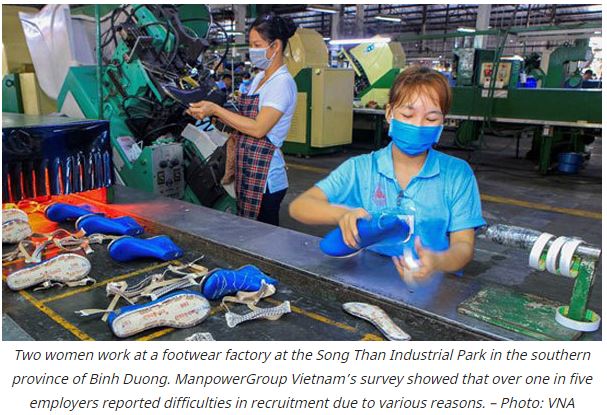Vietnam: Manufacturers face talent shortage amid Industry 4.0
Manufacturing businesses are facing a talent shortage under the digital transformation impact in the fourth industrial revolution (Industry 4.0), requiring them to set up holistic talent acquisition and development strategies.
ManpowerGroup Vietnam and the American Chamber of Commerce in Hanoi jointly hosted the webinar, “Tackling the talent shortage in manufacturing under Industry 4.0”, last week, during which business leaders and human resource experts discussed the future of manufacturing and sustainable solutions for manufacturers to overcome recruitment difficulties.
Nguyen Thu Trang, country head of Permanent Recruitment and Executive Search at ManpowerGroup Vietnam, kicked-off the discussion, talking about the main forces that impact the future world of work, including the rising tech acceleration.
According to The Future Factory white paper by the ManpowerGroup, new roles are born while many others are disappearing as global manufacturing becomes fully digital. In contrast with the industry growth outlook, global manufacturers, including those in Vietnam, are facing challenges in hiring the needed talent for growth.
According to a survey by ManpowerGroup Vietnam and the Institute of Labor Science and Social Affairs, over one in five employers report difficulties in recruitment due to various reasons. Among them, skills scarcity receives the greatest concern, with 70% of the surveyed employers sharing that candidates fail to meet technical skill requirements.
“To win in the digital age, an effective talent strategy should have four parts: build, buy, borrow and bridge. Build your talent pipeline, buy skills where necessary, borrow from external talent sources and bridge people with adjacent skills from one role to another to complement existing skills,” Trang said.
Tran Thi Thanh Huong, HR Manager at Gentherm Vietnam, a thermal management technologies company listed in the Fortune’s 100 Fastest Growing Companies, shared the current practices of talent sourcing, development and retention strategies since the company entered Vietnam in 2014.
While utilizing all sourcing channels, from building the database of their candidates to identifying and creating other potential talent pools such as partnerships with universities, Gentherm Vietnam has put a strong focus on learning and development programs for employees.
“We apply the 70-20-10 model for talent development. While 70% is played by on-the-job training, 20% is informal learning such as training within the industry, and 10% is formal training like the skill training matrix,” she said.
Regarding talent retention, Huong shared the diverse tools applied by the company, including a communication system to staff at all levels, employee belonging programs and the Korn Ferry Hay job evaluation method.
“Digital transformation is only at the early stage, and with the ongoing Covid pandemic, difficulties in finding new skills and new talent will continue in the next three to five years. Companies should be ready and proactive in preparation, particularly to improve workers’ skills with training and development plans,” Trang added.
The webinar, “Tackling the talent shortage in manufacturing under Industry 4.0”, saw the participation of nearly 50 business leaders and executives in recruitment, human resources and talent acquisition working in various industries.
Source: SGT


 Thailand
Thailand




